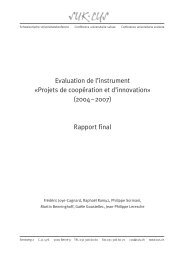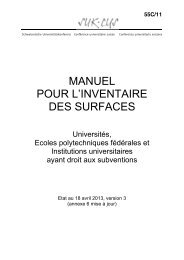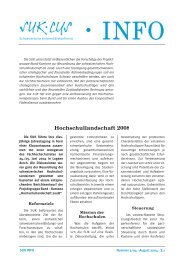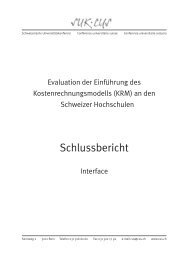Evaluation of the Swiss Virtual Campus - Schweizerische ...
Evaluation of the Swiss Virtual Campus - Schweizerische ...
Evaluation of the Swiss Virtual Campus - Schweizerische ...
Create successful ePaper yourself
Turn your PDF publications into a flip-book with our unique Google optimized e-Paper software.
SVC Final <strong>Evaluation</strong>. Background Report Lepori and Probst<br />
Overall, collaboration is rated well. But we can see that especially in some 3 rd and 4 th series<br />
projects, it is also seen as a complication, or has only been limited. It might be that <strong>the</strong>se issues<br />
emerge in <strong>the</strong> 3 rd and 4 th series because <strong>the</strong>se projects do not yet exist as long as 1 st and 2 nd<br />
series projects, where probably a way <strong>of</strong> handling <strong>the</strong> collaboration has already been found (or<br />
where project partners also have changed in <strong>the</strong> meantime). It is, however, interesting to see<br />
that only 22 projects strongly disagree with <strong>the</strong> statement that collaboration was more a<br />
complication in <strong>the</strong> work. Also during <strong>the</strong> monitoring visits, challenges have been reported: for<br />
example <strong>the</strong> difficulty <strong>of</strong> reconciling different points <strong>of</strong> view or o<strong>the</strong>r duties <strong>of</strong> <strong>the</strong> project<br />
members leading to delays in delivery.<br />
One could expect that in 3 rd and 4 th series projects, due to <strong>the</strong> smaller overall partner numbers,<br />
it was possible to develop better collaborations. This does, however, not hold true in our data:<br />
The share <strong>of</strong> projects disagreeing or strongly disagreeing with <strong>the</strong> statement that collaboration<br />
was limited (and thus saying that collaboration exists) remains more or less <strong>the</strong> same in <strong>the</strong> 1 st ,<br />
2 nd and 3 rd and even decreases in <strong>the</strong> 4 th series.<br />
Collaboration and exchange between projects from different teams, however, seems to be less<br />
intensive. At <strong>the</strong> monitoring visits, several projects seemed not to know about o<strong>the</strong>r projects in<br />
<strong>the</strong>ir own or a close domain (but at o<strong>the</strong>r HEIs), which could also be <strong>of</strong> interest to <strong>the</strong>m. Thus,<br />
exchange among projects <strong>of</strong> <strong>the</strong> same disciplinary fields could be an interesting tool for<br />
extending <strong>the</strong> impact <strong>of</strong> <strong>the</strong> SVC programmes.<br />
several times; 27<br />
regular; 7<br />
39<br />
not existing; 24<br />
once or twice; 21<br />
Figure 10. ‘How frequent was your relationship with o<strong>the</strong>r SVC projects similar to yours?’<br />
N =79<br />
Overall, it appears that <strong>the</strong> SVC projects have been effective in promoting and reinforcing <strong>the</strong><br />
collaboration between higher education institutions and that in most <strong>of</strong> <strong>the</strong> projects this<br />
collaboration was real and brought some benefits, even if, as some <strong>of</strong> <strong>the</strong> interviewed persons<br />
underscored, it certainly made <strong>the</strong> management <strong>of</strong> <strong>the</strong> projects more difficult and increased <strong>the</strong>ir<br />
costs.<br />
4.4 Involvement <strong>of</strong> CCSP<br />
Concerning <strong>the</strong> relationship between projects and CCSPs, we find two quite different situations:<br />
<strong>the</strong> SVC established CCSPs only in <strong>the</strong> consolidation phase, thus most 1 st and 2 nd series<br />
projects have originally been developed without <strong>the</strong> support <strong>of</strong> a CCSP, except in some places<br />
where such structures already existed before <strong>the</strong> SVC programme. For 3 rd series projects,<br />
involvement <strong>of</strong> <strong>the</strong> CCSP was mandatory and a fixed overhead for <strong>the</strong>ir services was included,<br />
while for 4 th series projects CCSP leaders had to sign <strong>the</strong> application.<br />
Some HEIs emphasised that <strong>the</strong> involvement <strong>of</strong> <strong>the</strong> CCSP allowed an internal selection <strong>of</strong><br />
projects so that those submitted were better designed than in <strong>the</strong> impulse phase and had a<br />
higher chances <strong>of</strong> being used in education, thus helping <strong>the</strong>ir sustainability in <strong>the</strong> future.










